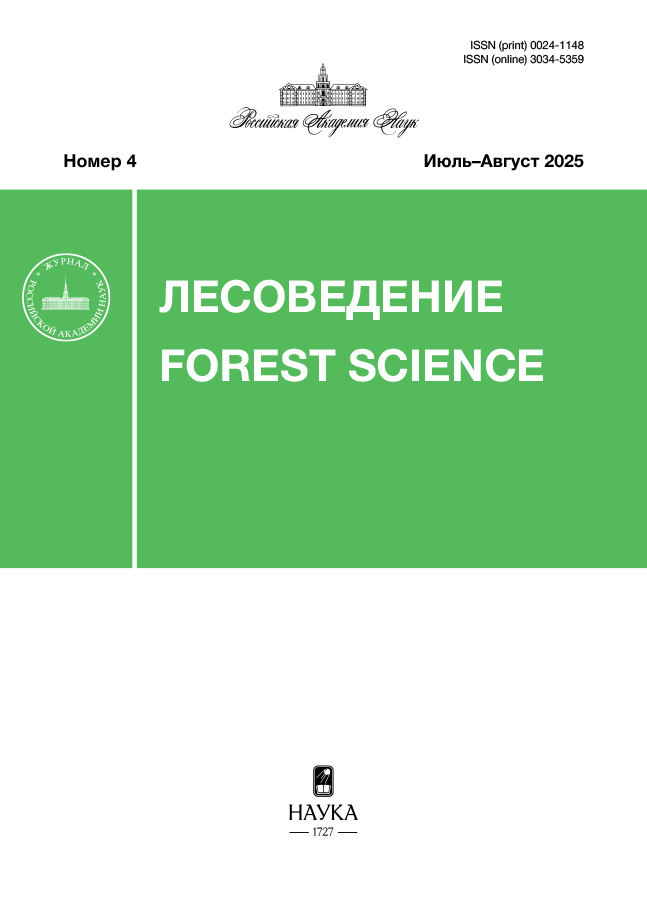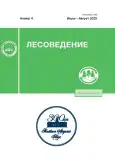Влияние лесорастительных условий на эмиссию СО2 с поверхности почвы среднетаежных сосняков Республики Коми
- Авторы: Осипов А.Ф.1
-
Учреждения:
- Институт биологии Коми НЦ УрО РАН
- Выпуск: № 4 (2023)
- Страницы: 369-378
- Раздел: ОРИГИНАЛЬНЫЕ СТАТЬИ
- URL: https://journals.rcsi.science/0024-1148/article/view/137864
- DOI: https://doi.org/10.31857/S0024114823040071
- EDN: https://elibrary.ru/XRZZVT
- ID: 137864
Цитировать
Полный текст
Аннотация
В связи с большими разбросами оценок эмиссии СО2 в лесных экосистемах разных типов актуальным остается получение экспериментальных данных по дыханию их почв. Цель работы − охарактеризовать выделение СО2 с поверхности почв спелых и приспевающих среднетаежных сосняков с учетом лесорастительных условий. Объектами исследования послужили сосняки сфагновые, черничный и бруснично-лишайниковый, произрастающие на территории лесных стационаров Института биологии Коми НЦ УрО РАН (Республика Коми). Для измерения эмиссии СО2 использовали газоанализатор LI-COR 8100 в течение 2008–2017 гг. Дана краткая характеристика погодных условий для периода исследований. В течение бесснежного периода относительно высокие значения потока СО2 из почвы сосняков выявлены в июле (сосняки сфагновые – 1.9–2.9 г С м–2 сут–1) и августе (2.5–6.6 г С м–2 сут–1 – сосняки черничный и бруснично-лишайниковый). Определены межгодовая вариабельность скорости среднемесячной эмиссии СО2 и влияние погодных условий. Выявлена тесная (R2 = 0.49–0.77) положительная взаимосвязь скорости выделения диоксида углерода с температурой почвы. Корреляция этого процесса с влажностью почвы слабая. В течение летних месяцев с дыханием почвы сосняка черничного в атмосферу выносится 188–442 г С м–2, вегетационного периода (01.05–30.09) – 279–563 г С м–2, бесснежного периода (01.05–31.10) – 308–583 г С м–2, что в 1.5–1.8 раза выше, чем в сосняках сфагновых и бруснично-лишайниковом в течение бесснежного (р = = 0.014) и вегетационного (р = 0.020) периодов. Достоверного влияния лесорастительных условий на потери С-СО2 в летние месяцы не выявлено (р = 0.106). Сосняки лишайниковый и сфагновые были сопоставимы по величине потока С-СО2 с поверхности почвы как в течение вегетации, так и бесснежный период (p > 0.05). Приведенные данные важны при определении расходной части баланса углерода в лесных экосистемах на европейском северо-востоке России.
Ключевые слова
Об авторах
А. Ф. Осипов
Институт биологии Коми НЦ УрО РАН
Автор, ответственный за переписку.
Email: osipov@ib.komisc.ru
Россия, 167982, Сыктывкар, ул. Коммунистическая, д. 28, ГСП-2
Список литературы
- Бобкова К.С. Биологическая продуктивность хвойных лесов европейского Северо-Востока. Л.: Наука, 1987. 156 с.
- Карелин Д.В., Почикалов А.В., Замолодчиков Д.Г., Гитарский М.Л. Факторы пространственно-временной изменчивости потоков СО2 из почв южнотаежного ельника на Валдае // Лесоведение. 2014. № 4. С. 56–66.
- Кузнецов М.А. Динамика содержания органического углерода в заболоченных ельниках средней тайги: автореф. дис. … канд. биол. наук: 03.02.08. Сыктывкар, 2010. 20 с.
- Курганова И.Н., Лопес де Гереню В.О., Мякшина Т.Н., Сапронов Д.В., Ромашкин И.В., Жмурин В.А., Кудеяров В.Н. Натурная и модельная оценки дыхания лесной дерново-подзолистой почвы в Приокско-Террасном биосферном заповеднике // Лесоведение. 2019. № 5. С. 435–448.
- Машика А.В. Эмиссия диоксида углерода с поверхности подзолистой почвы // Почвоведение. 2006. № 12. С. 1457–1463.
- Осипов А.Ф. Эмиссия диоксида углерода с поверхности почвы спелого сосняка черничного в средней тайге Республики Коми // Лесоведение. 2015. № 5. С. 355–366.
- Сморкалов И.А., Воробейчик Е.Л. Механизм стабильности эмиссии CO2 из лесной подстилки в условиях промышленного загрязнения // Лесоведение. 2016. № 1. С. 34–43.
- Bobrik A.A., Goncharova O.Yu., Matyshak G.V., Ryzhova I.M., Makarov M.I., Timofeeva M.V. Spatial distribution of the components of carbon cycle in soils of forest ecosystems of the northern, middle, and southern taiga of western Siberia // Eurasian Soil Science. 2020. V. 53. № 11. P. 1549–1560.
- Bond-Lamberty B., Thomson A. A global database of soil respiration data // Biogeosciences. 2010. V. 7. № 6. P. 1915-1926.
- Davidson E.A., Janssens I.A., Luo Y. On the variability of respiration in terrestrial ecosystems: moving beyond Q10 // Global Change Biology. 2006. V. 12. P. 154–164.
- Hashimoto S., Carvalhais N., Ito A., Migliavacca M., Nishina K., Reichstein M. Global spatiotemporal distribution of soil respiration modeled using a global database // Biogeosciences. 2015. V. 12. P. 4121–4132.
- Ivanov D., Tatarinov F., Kurbatova J. Soil respiration in paludified forests of European Russia // J. Forest Research. 2020. V. 31. P. 1939–1948.
- Jian J., Bahn M., Wang C., Bailey V.L., Bond-Lamberty B. Prediction of annual soil respiration from its flux at mean annual temperature // Agricultural and Forest Meteorology. 2020. V. 287. № 107961.
- Jian J., Vargas R., Anderson-Teixeira K., Stell E., Herrmann V., Horn M., Kholod N., Manzon J., Marchesi R., Paredes D., Bond-Lamberty B.P. A global database of soil respiration data, Version 5.0. ORNL DAAC, 2021. Oak Ridge, Tennessee, USA.
- Kadulin M.S., Koptsik G.N. Emission of CO2 by soils in the impact zone of the Severonikel smelter in the Kola subarctic region // Eurasian Soil Science. 2013. V. 46. № 11. P. 1107–1116.
- Kadulin M.S., Smirnova I.E., Koptsyk G.N. The emission of carbon dioxide from soils of the Pasvik nature reserve in the Kola subarctic // Eurasian Soil Science. 2017. V. 50. P. 1055–1068.
- Korkiakoski M., Tuovinen J.P., Penttila T., Sarkkola S., Ojanen P., Minkkinen K., Rainne J., Laurila T., Lohila A. Greenhouse gas and energy fluxes in a boreal peatland forest after clear-cutting // Biogeosciences 2019. V. 16. P. 3703–3723.
- Kučinskas O., Marozas V. Diurnal and seasonal soil CO2 efflux variation in Scots pine (Pinus sylvestris L.) forests in the European hemi-boreal zone, Lithuania // J. Elementology. 2021. V. 26. P. 731–754.
- Kurganova I.N., Lopes de Gerenyu V.O., Khoroshaev D.A., Myakshina T.N., Sapronov D.V., Zhmurin V.A., Kudeyarov V.N. Analysis of the long-term soil respiration dynamics in the forest and meadow cenoses of the Prioksko-Terrasny biosphere reserve in the perspective of current climate trends // Eurasian Soil Science. 2020. Vol. 53. № 10. P. 1421–1436.
- Masyagina O.V., Evgrafova S.Y., Menyailo O.V., Mori S., Koike T., Prokushkin S.G. Age-dependent changes in soil respiration and associated parameters in Siberian permafrost Larch stands affected by wildfire // Forests. 2021. V. 12. P. 107.
- Masyagina O.V., Menyailo O.V., Prokushkin A.S., Matvienko A.I., Makhnykina A.V., Evgrafova S.Yu., Mori S., Koike T., Prokushkin S.G. Soil respiration in larch and pine ecosystems of the Krasnoyarsk region (Russian Federation): a latitudinal comparative study // Arabian J. Geosciences. 2020. V. 13. P. 954.
- Mukhortova L., Shchepashchenko D., Shvidenko, A. Soil respiration database. 2020. http://dare.iiasa.ac.at/107/
- Mukhortova L., Schepaschenko D., Moltchanova E., Shvidenko A., Khabarov N., See L. Respiration of Russian soils: Climatic drivers and response to climate change // Science of The Total Environment. 2021. V. 785. 147314.
- Osipov A.F. Effect of interannual difference in weather conditions of the growing season on the CO2 emission from the soil surface in the middle-taiga cowberry–lichen pine forest (Komi Republic) // Eurasian Soil Science. 2018. V. 51. № 12. P. 1419–1426.
- R Core Team. R: A language and environment for statistical computing. R Foundation for Statistical Computing.Vienna, 2020. https://www.R-project.org/
- Sha L., Teramoto M., Noh N.J., Hashimoto S., Yang M., Sanwangsri M., Liang N. Soil carbon flux research in the Asian region: Review and future perspectives // J. Agricultural Meteorology. 2021. V. 77. № 1. P. 24–51.
Дополнительные файлы













